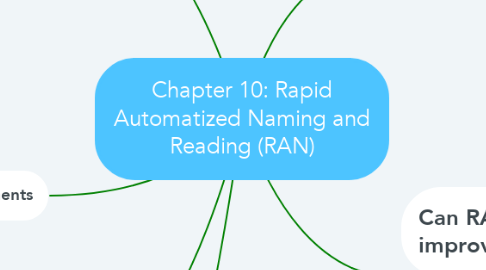
1. Why is RAN related to reading
1.1. RAN and Phonological Processing: the rate of retrieval of phonological information from long-term memory and related to reading related to phonological processing
1.1.1. RAN and orthographic processing: how rapidly and effortlessly individuals can access the names of common symbols (digits, letters) which has a significant effect on learning and retrieving orthographic patterns. Letter recognition
1.1.2. RAN and Speed of processing: RAN-reading link reflects a global development change in processing speed. Speed will either increase or decrease during childhood development. Speed of processing. Needs to develop into automatic retrieval.
1.2. A developmental account: cognitive processing skills, phonological awareness, orthographic processing and speed of processing were to be considered simulated and developed. May change over time related to reading.
2. RAN components
2.1. measuring the total performance time in RAN takes fails to provide the precision needed to determine adequately the nature of RAN and that interest should be turned to intreats compounds, such as the time between articulation time. Phonological and orthographic relationship
3. What Factors influence the RAN-reading relationships?
3.1. STIMULI: objects, colours, digits and letters. Either non-alphanumeric or alphanumeric
3.1.1. Effects of time, reading ability level, and types of reading outcomes. When is RAN used, later versus early on. The types of treading outcomes, poor versus good readers.
3.1.2. Effects of orthography: the effects of the children learning to read, constant versus inconsistent.
4. Conclusions and future directions
4.1. studies have shown that RAN is a strong predictor of reading acquisition and a cognitive marker of developmental dyslexia. The nature of RAN and reading abilities will continue to be researched
4.1.1. It has increased in popularity because of three factors 1. RAN measures are relatively easy to administer and have improved the diagnostic value of screening batteries 2. RAN has helped explain aspects of reading disabilities that could not be explained by phonological awareness 3. RAN has been found to predict reading over and above the contribution of other cognitive processes.
5. The Double-Deficit Hypothesis
5.1. RAN can be shown in reading disabilities. DDH 1. one with no deficits 2. with single deficits in either phonological awareness or RAN. Or one with both deficits in both phonological awareness and RAN
6. Can RAN performances be improved?
6.1. - Letter naming speed only improves when training in letter naming followed the orthographic training.
6.1.1. -Promoting may also help. -There has been little systematic research examining how RAN performance can be improved.

